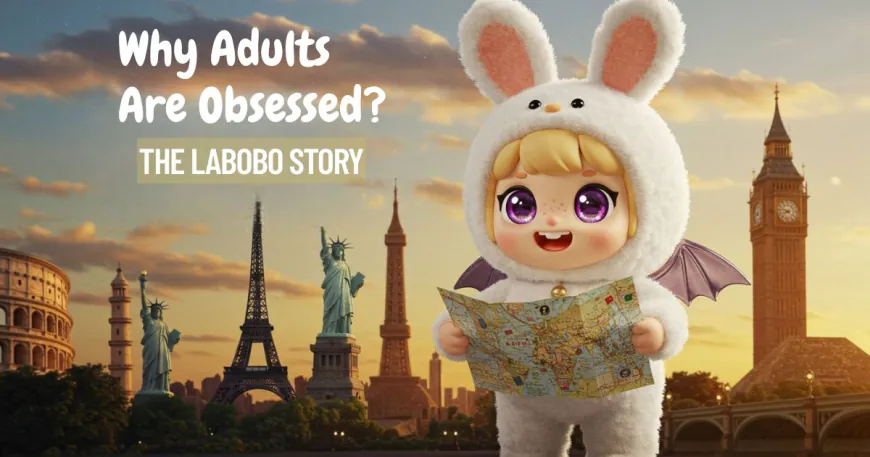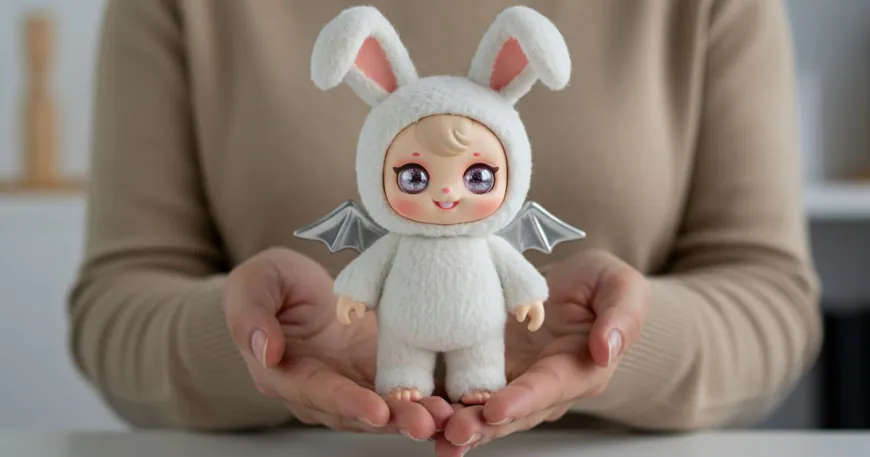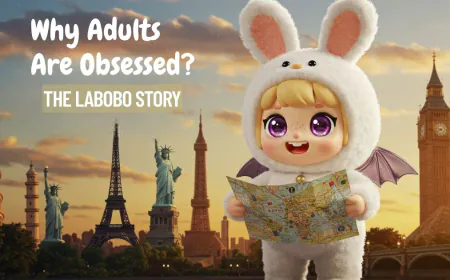Labubu: Why Adults Are Obsessed With This Collectible Art Toy
Dive into the Labubu doll phenomenon. Discover why Kasing Lung's creepy-cute art toy has become a global obsession for adults, from blind boxes to celebrity influence.

Stitched from Anxiety: Why Labubu Dolls are the Unlikely Icons of Our Times
Introduction
One does not merely decide to learn about the Labubu doll; one is eventually confronted by it. It might appear clutched in the hand of a global superstar like BLACKPINK’s Lisa, peeking out from a luxury handbag, or it might flood your social media feed in a frenzy of “unboxing” videos. At first glance, it is a paradox: a palm-sized vinyl creature, often with large, elfin ears and a fluffy ruff, that teeters on a fine line between endearing and unsettling. It is at once a child’s plaything and an adult’s prized possession.
This is the story of Labubu, the vinyl art toy that has transcended its origins to become a global trend. But the critical question is not what it is, but why it has captured the collective adult imagination so fiercely. The answer reveals a great deal about our current cultural moment—our anxieties, our desires, and our complex relationship with nostalgia.

The Anatomy of an Icon: Folklore Meets Hype Culture
To understand Labubu, one must first understand its creator. The dolls are the brainchild of Kasing Lung, a Hong Kong-born, Netherlands-based artist renowned for his illustrated world of whimsical, monster-like sprites. First appearing in his enchanting storybooks, these characters draw from a deep well of European folklore, blending the innocent aesthetic of fairy tales with a subtle, melancholic strangeness.
Labubu emerged from this creative universe and was first introduced to the market in 2019. Each figure is a masterclass in juxtaposition: the button-like eyes are devoid of emotion, yet the character’s context feels expressive. Some are dressed as monsters, others as fruits; their forms are unpredictable, tapping into a design language that is both playful and vaguely sinister. This “morbidly adorable” quality is central to their appeal, allowing them to be perceived not as simple toys, but as miniature sculptures with a distinct artistic point of view.
The Architecture of Desire: Scarcity and Serendipity
A key driver of the Labubu craze is its brilliantly executed commercial strategy, primarily in partnership with Chinese retail giant Pop Mart. The dolls are most often sold in "blind boxes," a retail model that gamifies the act of purchasing. The buyer does not know which specific design they will receive, only that it belongs to a particular series.
This model achieves two things with potent psychological effect: First, it manufactures scarcity. With some designs being significantly rarer than others (the coveted "secret" figure), a powerful collector’s impulse is triggered. The inability to simply buy the desired item creates immense secondary market value and a sense of trophy-hunting. Second, it provides a dopamine rush. The unboxing process delivers a hit of anticipation and surprise, akin to a lottery ticket. This element of chance transforms a simple transaction into a memorable, shareable experience, perfect for the ephemeral content cycles of TikTok and Instagram.
The Celebrity Catalyst and the Digital Firestorm
While the blind box model built a dedicated following in the art toy community, Labubu’s explosion into the mainstream was fueled by the unparalleled power of modern celebrity. When figures like Lisa from BLACKPINK and Rihanna were photographed with their Labubus, the doll was instantly reframed. It was no longer just a collectible; it was a status symbol, an accessory, a piece of cultural currency.
This celebrity endorsement acted as a powerful social proof, signaling to a global audience that these dolls were not for children, but for discerning, trend-aware adults. The ensuing media attention and social media amplification created a feedback loop of desire, turning a niche interest into a full-blown global phenomenon that peaked in 2023 and continues to thrive.
The Sociological Lens: A Cuddly Antidote to Modernity
Phenomena like this do not occur in a vacuum; they are a direct reflection of our socio-cultural climate. As noted by design theorists and cultural critics, the rise of "kidulting"—where adults engage with media and products traditionally associated with childhood—is a significant trend. The Labubu doll is perhaps its most potent artifact.
In an era defined by digital saturation, political uncertainty, and immense social complexity, a small, tangible object offers a powerful psychological retreat. The Labubu represents a flight to a world of simplified emotions and tangible comfort. As American design academic Gozde Guncavdi Burke has noted on such trends for The Guardian, these objects can represent a collective escape from the overwhelming pressures of modern life into a simpler, more childlike state of being.
The Labubu, in its silent, enigmatic charm, asks nothing of its owner. It is a companion without demands, a piece of art that can be held, and a nostalgic anchor to a less complicated time—even if that time is an imagined one. It is, in essence, an emotional support object for the anxious modern adult.
Frequently Asked Questions
1. What, precisely, is the relationship between the artist Kasing Lung and the retailer Pop Mart?
The relationship is a symbiotic one, representing a new model for commercialising art in the 21st century. Kasing Lung is the independent artist and creative force; he is the originator of the Labubu character and its narrative universe. Pop Mart, a powerhouse in the "cultural lifestyle" retail space, acts as the primary global partner for production and distribution. They effectively translate Lung’s artistic IP (Intellectual Property) into high-quality vinyl collectibles, leveraging their immense manufacturing and marketing infrastructure to reach a mass global audience that an independent artist could not. In essence, Lung provides the soul, and Pop Mart provides the vessel and the voyage to the mainstream.
2. Why do some Labubu figures command such extraordinarily high prices on the resale market?
The high valuation of certain Labubu figures is a direct result of meticulously engineered scarcity. The "blind box" system ensures that while any purchase guarantees a figure from a given series, the probability of acquiring each specific design is not equal. Within each series, there are common figures and then one or more "Secret" or "Chase" figures, which are produced in far smaller quantities. This creates a hierarchy of rarity. A standard Labubu might be a delightful collectible, but a "Chase" figure is a trophy. This system fuels a vibrant secondary market where collectors, driven by the desire for completion or the status of owning a rare piece, are willing to pay significant premiums, turning the hobby into a dynamic, and at times speculative, marketplace.
3. Beyond the trend, what is the deeper cultural significance of adults collecting these dolls?
The Labubu phenomenon serves as a fascinating cultural barometer. On one level, it represents the maturation of the "kidult" economy, where the traditional lines between adult and youth pastimes have completely dissolved. Adults no longer feel compelled to "put away childish things" and instead embrace them as legitimate hobbies. On a deeper level, collecting Labubus signifies a search for tangible comfort and control in an increasingly digital and chaotic world. Each physical, curated doll offers a small, aesthetic anchor in an ephemeral reality. It is also a form of identity curation; a collection displayed on a shelf is a silent, visual declaration of one's tastes, participation in a global community, and appreciation for a particular artistic vision.
Conclusion: A Mirror to Our Modern Age
Ultimately, the story of Labubu is not one of vinyl and paint, but a compelling narrative of contemporary culture itself. It demonstrates a fascinating paradox in our digital age, exploring
how technology is affecting cultural preservation
not by destroying old forms, but by creating fervent new demands for physical, collectible artifacts. These dolls become extensions of the self, potent symbols in a world constantly examining
the impact of culture on society and identity formation
Labubu, in all its creepy-cute glory, holds up a mirror to our times, asking us what we truly value and why we collect. We invite you to join the conversation. What do you believe this trend says about us? Share your perspective in the comments below.
What's Your Reaction?



















































